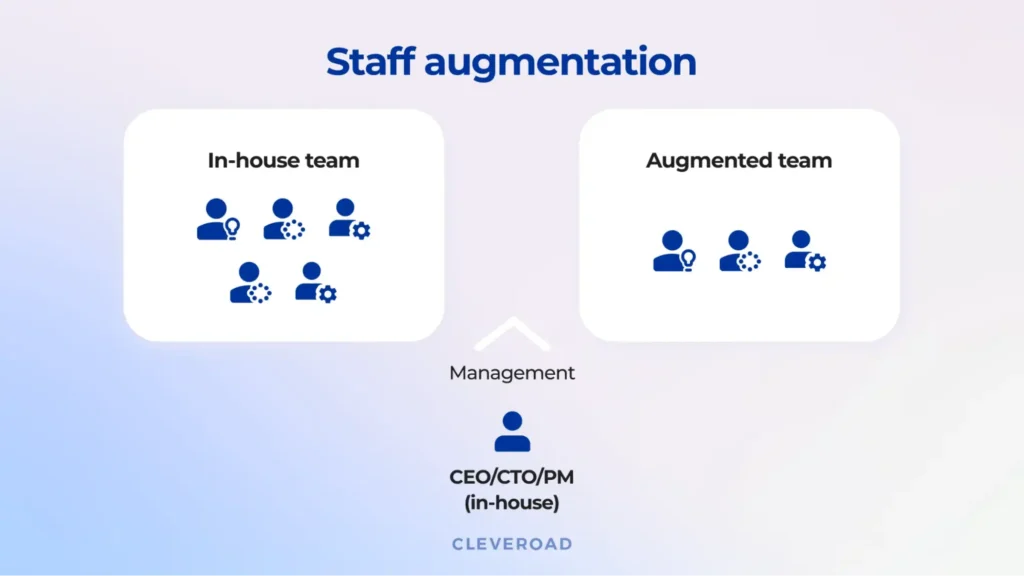Deciding on the optimal strategy for scaling business operations and enhancing technological capabilities can significantly impact a company’s agility and economic efficiency.
Many businesses are now turning to outsourcing IT support as a strategic move, drawn by the potential for enhanced efficiency, cost savings, and time management.
In fact, according to research, the most widely cited reason for outsourcing IT functions is to free up resources to focus on core business activities, accounting for 49%.
However, business leaders frequently encounter the challenge of deciding between staff augmentation and managed services.
Brian Leger, Co-Founder of InfoTECH Solutions, says, “This decision is not just about filling gaps; it’s about aligning with your strategic goals without overspending or undermining your project’s quality.”
Understanding the differences and implications of each model can empower you to make informed choices that are tightly aligned with your company’s needs and future objectives.
Staff Augmentation vs Managed Services: Exploring the Definitions
Staff augmentation is a flexible outsourcing strategy that allows companies to hire tech talent globally and manage augmented teams directly.
This approach is particularly beneficial for companies looking to extend their existing teams on short-term projects or when specific skills are temporarily required.
The key advantage is the ability to maintain complete control over the work process, ensuring that the external employees blend seamlessly with the in-house teams.
Managed Services: A Comprehensive Approach
The managed services model entrusts a third-party provider with the responsibility for the services provided, including handling entire segments of business processes. According to research from CloudSecureTech, 64% of businesses now utilize managed IT services, underscoring its increasing adoption.
Managed services cover everything from software development to full IT support, with the service provider taking charge of the team and its management. According to a report by Grand View Research, the global market for managed services is projected to grow at a compound annual growth rate (CAGR) of 13.6% from 2023 to 2030.
This model is suited for companies looking to offload specific operational burdens to focus more intensively on their core business.
IT Management Challenges Slowing Down Your Growth?
Let InfoTECH Solutions optimize your IT for scalability and performance.
Learn MoreKey Differences and When to Use Each.
1. Project-Based vs Ongoing Needs
Staff Augmentation: Ideal for project-based needs where the requirement is temporary and highly specialized.
Managed Services: Suited for ongoing, continuous operational needs where outsourcing can help streamline and optimize processes.
2. Cost Effectiveness and Long-Term Costs
Staff Augmentation: Can be cost-effective for short-term projects but might increase long-term costs if relied upon consistently for expanding workforce needs.
Managed Services: Might involve higher initial costs but tend to be more cost-efficient in the long run due to economies of scale and reduced overhead.
3. Control vs Convenience
Staff Augmentation: Allows businesses to keep all operations in-house, offering complete control over staff and project management.
Managed Services: Relinquish certain control in exchange for convenience and efficiency, with professionals handling everything as per contractual obligations.

Source: Cleveroad
4. Scalability vs Stability
Staff Augmentation: Provides the flexibility to quickly scale up or down depending on project demands without committing to long-term employment contracts.
Managed Services: Offers a stable, consistent service delivery model that is less affected by fluctuations in workload, ensuring uninterrupted operations.
5. Specialized vs Holistic Support
Staff Augmentation: Enables access to highly specialized skills for specific projects without needing permanent hires, catering to niche requirements.
Managed Services: Provides a broad range of IT support and services, ensuring comprehensive coverage without the need to manage each expert individually.
6. Integration vs Outsourcing
Staff Augmentation: Seamlessly integrates with existing team dynamics and workflows, enhancing the in-house capabilities without significant changes to internal processes.
Managed Services: Often involves outsourcing entire functions, which can lead to transformative changes in how IT services are delivered and managed, potentially introducing new methodologies and technologies.
Advantages and Disadvantages of Staff Augmentation vs Managed Services
Benefits of Staff Augmentation
1. Flexibility to Scale Workforce Up or Down Quickly
Staff augmentation provides businesses with the agility to adjust their workforce size based on current project demands and market conditions without the long-term commitments associated with hiring full-time employees. This ability to scale helps companies stay lean and efficient, adapting quickly to new opportunities or downturns.
2. Direct Oversight of How Tasks Are Accomplished
With staff augmentation, external staff work under the direct supervision of the company’s management, ensuring that all tasks align with the company’s standards and practices. This setup maintains consistency in quality and allows managers to directly influence project outcomes.
3. Integration with Existing Team Enhances Collaboration
Augmented staff often work alongside the existing team, which fosters a collaborative environment. This setup helps in sharing knowledge and skills, leading to innovation and a more cohesive team dynamic.
Challenges with Staff Augmentation
1. Higher Management Overhead
Managing augmented staff requires significant time and resources from a company’s management and HR departments. From onboarding to supervision, the administrative burden is considerably higher compared to managing a stable, long-term team.
2. Potential for Inconsistent Work Quality from Temporary Staff
As augmented staff may vary from project to project, there can be variability in the quality and efficiency of the work delivered. Frequent changes in personnel can also disrupt team dynamics and project continuity.
3. Dependency on Finding the Right Talent Promptly
The success of staff augmentation heavily relies on the ability to find the right talent at the right time. Delays in hiring or mismatches in skill sets can lead to project delays and increased costs.
Benefits of Managed Services
1. Predictable Costs with Fixed Service Fees
Managed services are typically provided under a contract with fixed monthly fees, which makes budgeting easier and financial planning more predictable. This setup eliminates the variability of project-based or hourly billing associated with temporary staff.
2. Reduced Burden on Internal Staff
By outsourcing IT functions or other business processes to a managed services provider, companies can alleviate the workload on their internal teams. This reduction allows staff to focus more on strategic tasks and core business functions, enhancing productivity and job satisfaction.
3. Access to a Wider Range of Expertise Without Hiring Full-Time Employees
Managed services offer access to a broad spectrum of skills and expertise that might be too costly or impractical to maintain in-house. This is especially beneficial for small to medium-sized enterprises that may not have the resources to employ specialists in areas like cybersecurity, data analytics, or advanced software development.

Source: TechTarget
Challenges with Managed Services
1. Less Control Over How Specific Tasks Are Executed
Opting for managed services means relinquishing some control over how specific tasks are carried out. The service provider will manage tasks based on their methods and standards, which might not always align perfectly with the client’s expectations or company culture.
2. Potential Risks Associated with Handing Over Business Processes to an External Party
There are inherent risks in outsourcing critical business functions, including potential security risks and the possibility of service interruptions. Dependence on an external provider also means that any issues they face could directly impact the client’s operations.
3. Adjusting to the Service Provider’s Way of Working
Transitioning to managed services often requires adjustments in internal processes and workflows. This change can be challenging for staff and management alike as it might involve adopting new technologies, following different operational protocols, or communicating through new channels. The adjustment period can impact productivity and require additional training and support.
Staff Augmentation vs Managed Services: Quick Glance
| Feature | Staff Augmentation | Managed Services |
| Resource Flexibility | High flexibility to change team size | Fixed team size as per agreement |
| Skill Adaptability | Specific skills recruited for each project | Broad range of skills continuously available |
| Budget Variability | Costs fluctuate with team size | Fixed monthly or annual costs |
| Contract Length | Short-term contracts, project-specific | Long-term contracts, ongoing services |
| Setup Time | Longer due to recruitment and onboarding | Quick setup if provider has resources ready |
| Impact on Overhead | Increases with management and training | Reduced overhead with outsourced management |
Drive Business Excellence With InfoTECH Solutions
Navigating the complexities of whether to employ staff augmentation or managed services is pivotal for businesses aiming to optimize their operational efficacy and financial management.
Companies must constantly adapt to dynamic market conditions, making informed decisions that resolve short-term resource needs and align with long-term strategic goals.
InfoTECH Solutions, boasting two decades of expertise in managed services and IT support, stands ready to assist you in dissecting these choices.
Discover Trustworthy Managed IT Services Near You:
With their tailored solutions, businesses can confidently address their immediate project requirements and broader operational demands.
Connect with us today for a free consultation to ensure your resource management strategies propel your business toward sustained growth and success.



